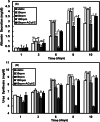Alginate-chitosan core-shell microcapsule cultures of hepatic cells in a small scale stirred bioreactor: impact of shear forces and microcapsule core composition
- PMID: 33865460
- PMCID: PMC8052835
- DOI: 10.1186/s13036-021-00265-6
Alginate-chitosan core-shell microcapsule cultures of hepatic cells in a small scale stirred bioreactor: impact of shear forces and microcapsule core composition
Abstract
A small scale stirred bioreactor was designed and the effect of different agitation rates (30, 60 and 100 rpm) was investigated on HepG2 cells cultured in alginate-chitosan (AC) core-shell microcapsule in terms of the cell proliferation and liver-specific function. The microencapsulated hepatic cells could proliferate well when they were cultured for 10 days at 30 rpm while the cell-laden microcapsules showed no cell proliferation at 100 rpm in the bioreactor system. Albumin production rate, as an important liver function, increased also 1.8- and 1.5- fold under stirring rate of 30 rpm compared to the static culture and 60 rpm of agitation, respectively. Moreover, In comparison with the static culture, about 1.5-fold increment in urea production was observed at 30 rpm. Similarly, the highest expressions of albumin and P450 genes were found at 30 rpm stirring rate, which were 4.9- and 19.2-fold of the static culture. Addition of collagen to the microcapsule core composition (ACol/C) could improve the cell proliferation and functionality at 60 rpm in comparison with the cell-laden microcapsules without collagen. The study demonstrated the hepatic cell-laden ACol/C microcapsule hydrogel cultured in the small scale stirred bioreactor at low mixing rate has a great potential for mass production of the hepatic cells while maintaining liver-specific functions.
Keywords: Hepatocytes; Mass production; Microencapsulation; Shear rate; Small scale stirred bioreactor.
Conflict of interest statement
The authors declare that they have no competing interests. There is no conflict of interest in the reporting of this data by any author.
Figures





References
-
- Figaro S, Pereira U, Dumé A, Rada H, Capone S, Bengrine A, et al. Suppliver: bioartificial supply for liver failure. IRBM. 2015;36(2):101–109. doi: 10.1016/j.irbm.2015.01.010. - DOI
-
- Lee JS, Cho S-W. Liver tissue engineering: recent advances in the development of a bio-artificial liver. Biotechnol Bioprocess Eng. 2012;17(3):427–438. doi: 10.1007/s12257-012-0047-9. - DOI
LinkOut - more resources
Full Text Sources
Other Literature Sources

